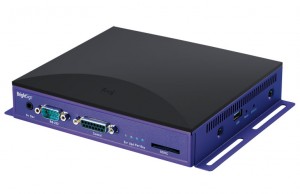 A couple of months ago, a friend approached me and asked if I would be interested in talking to his company about a video display solution. They were going to install new displays for video playback and wanted to do something better than the traditional DVD players many people use for just such a thing.
A couple of months ago, a friend approached me and asked if I would be interested in talking to his company about a video display solution. They were going to install new displays for video playback and wanted to do something better than the traditional DVD players many people use for just such a thing.
Their initial thought was to use a ROKU. The device is very affordable, supports HD, and plays back video like a champ. The only problem with the ROKU is that it’s not really designed for this type of job. It depends on user input and interaction. Because it depends on that, you can’t auto-start your video(s) when the device powers on. A potentially bigger problem is that anyone with a ROKU remote could hijack your device and play anything they wanted.
I suggested BrightSign. It’s very similar to the ROKU (owned by the same people) in many ways but is more of a professional device created for digital signage. You can use it standalone to just play video, audio, images and text or make it interactive via touchscreen, buttons, etc. You can sync multiple television screen across multiple units and create video walls or nifty orchestrated displays. BrightSign has some good case examples on their website.
BrightSign is probably one of the best digital signage devices I’ve seen. There really is a lot you can do with these boxes. You can either program the device to run standalone (throw everything on an SD card and leave it) or in network mode (check a URL frequently to see if there is new content). Network mode assumes that when the device is turned on that there will be a network connection. If you tell it to run in network mode, you put all of your content on a web server. The device goes to the URL you specify and downloads the new content and the XML that tells it what to play and when. There is also the option to use the BrightSign network and that gives you the ability to monitor and control all of your BrightSign devices. There is also a charge per device to use their network.
The biggest problem I have with them is the lack of documentation on how to program it. They use a programming language called BrightScript. And no, it’s not like JavaScript. For example, I had a problem where the solution was to delete certain files from the SD card and copy others from a sub-folder. Nowhere is it documented how to do that. You can look at the autorun file that their software creates for you and find three or four different commands that will delete files. You can find just as many that will move files around the SD card. So do I use “sd:/foldername/filename” or do I use “foldername/filename”? Can I use CopyFile(autoplayPoolFile$, “autoplay.xml”)? Turns out none of those worked for me, yet they are used in other locations within their default app.
I finally got it. That’s not the point. I would have gotten there a lot sooner had I been able to look in a PDF and find the code I needed. I ran into this time and time again. I did discover commented lines in their own code that kept me amused. For example, “This should be improved in the future to work out whether the sync spec we’re currently satisfying matches the one that we’re currently downloading or not.” At least they know there is room for improvement. And MUCH to their credit, I was able to actually talk to them late at night and over the weekend to help resolve some of my questions.
The bottom line is that BrightSign is a great solution if you have a digital signage need. You would be surprised at the number of companies that do! Whether it’s displaying video to a customer, statistical graphs and data for your corporation, a menu out front your local restaurant, or an interactive game, BrightSign can do it.